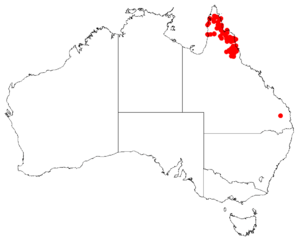Hakea persiehana facts for kids
Quick facts for kids Hakea persiehana |
|
|---|---|
| Scientific classification | |
| Genus: |
Hakea
|
| Species: |
persiehana
|
 |
|
| Where Hakea persiehana grows in Australia | |
Hakea persiehana is a special kind of shrub or small tree. It belongs to a group of plants called Hakea. There are about 150 different types of Hakea plants, and they all grow only in Australia. Many Hakea plants release their seeds when something big happens, like a bushfire. This helps new plants grow after a fire. Other types might need heavy rain to start growing. Hakea plants are part of the Proteaceae family.
Contents
What Hakea persiehana Looks Like
Hakea persiehana can grow as a shrub or a small tree. It usually reaches a height of about 3 to 10 meters (10 to 33 feet). It has branches that spread out, forming a wide top. Its bark is dark grey and looks like cork, with deep grooves.
Its leaves are long and thin, like a pencil. They are about 8 to 28 centimeters (3 to 11 inches) long and less than 1 millimeter wide.
This plant produces many cream-white flowers. You can see about 50 to 100 flowers in one cluster. They usually bloom between November and February. Sometimes, they also flower in May or June.
After flowering, it grows a fruit that looks like an egg. It's about 4.5 to 5.5 centimeters (1.8 to 2.2 inches) long and 2 to 2.7 centimeters (0.8 to 1.1 inches) wide. The fruit has a small, curved tip that is about 1 to 2 millimeters long.
How Hakea persiehana Got Its Name
The plant Hakea persiehana was first officially described in 1886. This was done by a scientist named Ferdinand von Mueller. He wrote about it in a science magazine called the Australasian Journal of Pharmacy.
The plant was named after a person named W. Anthony Persieh. He was a druggist, which is like a pharmacist. Mr. Persieh was also a very active collector of plants from Queensland for Ferdinand von Mueller.
Where Hakea persiehana Lives
Hakea persiehana grows in a specific part of Australia. You can find it on the Cape York Peninsula. This is a large piece of land that sticks out into the ocean in far North Queensland. It grows as far south as a town called Atherton.
This plant usually grows in open woodlands. These are areas where trees are not too close together. It often grows alongside other common Australian trees like Eucalyptus and Melaleuca.
Is Hakea persiehana Safe?
The Department of Environment and Science in Queensland, Australia, keeps track of plants and animals. They have looked at Hakea persiehana. They consider it to be of "least concern." This means that the plant is not currently in danger of disappearing. It is quite common and has a healthy population.

